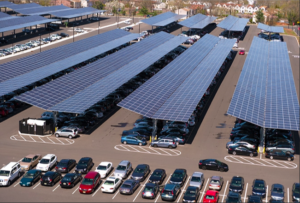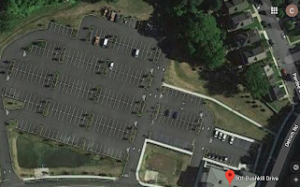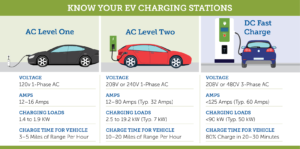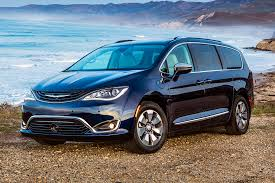Introduction:
The technical context for our group was especially important to create a system that was effective in achieving our goal of emissions reduction. We needed to create a system that was sustainable and actively supported the reduction of emissions on our campus without shifting the location of the emissions. We focused on the three major components of sustainable energy production, the transfer of energy from production to a vehicle, and finally the vehicle itself. For our project these 3 components take the form of solar carports, electric car chargers, and a fleet of electric / plug in hybrid vehicles. These 3 distinct pieces ensure that the energy the cars are receiving and using are emitting the lowest possible carbon.
Solar Canopies:
The production of energy is the most important factor in reducing emissions. Without producing some form of clean sustainable energy, emissions from the college fleet are not actually being reduced. They only shift emissions from the use of oil to the electric grid that would be used as a power source for the vehicles. A solar carport or canopy can provide the opportunity to utilize solar panels to produce the energy needed to power the newly purchased electric or plug in hybrid vehicles as well as multiple charging stations.
What is a solar canopy?
Referencing the picture below, a solar canopy is a multi-functional roof structure located above a paved area such as a parking lot. The most important component is that it generates energy using the solar panels located all over the protective cover area. However, this structure also provides shade for cars during the summer months and acts as a snow cover for cars during the winter months. As an alternative to rooftop solar, solar parking canopies are installed above parking lots negating the need for the roof of a building in order to install panels. The elevated nature of the canopy allows for a car or series of cars to be parked underneath the structure. The structure then generates power from solar energy, utilizing its 10 degree tilt to capitalize on capturing energy throughout the day. These canopies include solar panels and inverters to convert the direct current into usable alternating current. Solar canopies have become a popular trend in recent years as schools, communities, and cities look to take advantage of wasted paved spaces. Rutgers University boasts an array of solar canopies that produce electricity for the school. “The 32-acres of solar canopies generate eight megawatts (mW) of power, or approximately $1.2 million in electricity – equivalent to the annual energy consumption of nearly 1,000 households” (Miranda, 2011). This proves that colleges are taking initiatives to become more sustainable and that solar canopies are a viable source of energy to help achieve carbon neutrality.

Figure 5: “Parking Lot Solar Canopy”, (Cincinnati Zoo, 2011)
Our intention is to use a group of solar canopies similar to the one pictured above and the one described at Rutgers University in order to produce energy for the electric car chargers as part of our plan to reduce emissions. This type of system has been integrated with success at other institutions of higher learning such as IIT [Illinois Institute of Technology], where a solar canopy along with six level 2 chargers were implemented in order to charge electric vehicles on campus (Tian 1).

Figure 6: “Rutgers Solar Canopy”, (Rutgers University, 2019)
Where to put the solar canopies?
The prime location for implementing solar canopies is the Bushkill parking lot at 901 Bushkill Drive. The 302 spot parking lot is roughly 75,000 square feet, providing plenty of room for the implementation of solar canopies (Lafayette College Technology Clinic 31). A 50kW solar canopy suggestion would require 3,526 square feet of space. This would cover less than 5% of the Bushkill parking lot and thus provide minimal inconvenience during the construction process. The college can also make the canopy larger if it also wants to use the electricity generated to power surrounding light or the Public Safety building. Additionally, with little to no high structures or trees impeding the sunlight, the lot provides an ideal location open to the sky for solar energy production. The open lot is not currently operating at maximum capacity meaning there is plenty of room to be set aside for electric charging areas. All of these factors along with the close proximity of public safety and campus facilities being on either side of the lot makes this area perfect for the implementation of the energy production and distribution parts of our plan.

Figure 7: “Bushkill Parking Lot”, (Google Maps, 2019)
How much energy can be produced by a solar canopy?
The amount of energy produced by the canopy is tied to two major factors. The first of which we cannot control is the weather. A common misconception is that solar panels lose a majority of their production on a cloudy day. This is largely untrue as most solar panels only suffer a reduction in production of around 10% to at most 25%. (Paradise Solar Energy, 2019) But a reduction is a reduction so we must keep this in mind that the power production will vary from day to day. The second factor that will impact the amount of electricity produced by the system is the number of canopies that we install over the available parking space. With each additional canopy more electricity can be harvested and therefore passed on to charge the electric fleet of vehicles. Through our calculations outlined below we have discerned that in order to power one vehicle we need to implement roughly 28.8 solar panels. Therefore to accommodate the charging of at least 25% of the fleet each day we would need ten times the 28.8 figure making the total panels needed 288. The beauty of the solar canopy is that the design is flexible and can be structured to meet differing panel demands.
[This figure assumes the cars would not need to be charged each day and instead only roughly 10 cars a day would need to receive a full charge]

Figure 8: “Solar Panel Calculations”, (Currie, 2019)
Our group assumed a Lafayette owned vehicles travel 20 miles a day for analysis purposes. For a vehicle to receive a 20 mile charge, it would require 6.3kWh of energy. The economic analysis provides more detail to determine the optimal canopy size, and encouraged the recommendation of a 50kW solar canopy with a square footage of 3,526 (Solar Electricity Supply, Inc). Easton averages 4.5 to 5 kWh/m^2/day which is known as peak sun hours (Solar Power Rocks). Assuming 4.75 peak sun hours, a 50kW solar canopy should produce 237.5kWh of energy per day. This amount of energy should power every car and then be able to sell the excess energy back to the grid, providing Lafayette with added benefits. These monetary benefits are further expanded upon in the economic section.
Additional Technical Benefits of Solar Canopies
In addition to the obvious benefit of producing renewable alternative energy to power our fleet, the solar canopies offer a host of other benefits to the college fleet and the greater Lafayette community’s vehicles. These include an increase in shade, weather protection, tan credits, and a maximization of available space here on campus. The implementation of these solar canopies will create a structure that any vehicle can park under whether is is electric or not. It has been proven that a cars air conditioning on a hot day can increase the total emissions from a vehicle over the course of driving. (EPA, 2019) By utilizing the shade produced by the structures the average temperature will likely decrease resulting in reduced emissions from cars on Lafayette’s campus. Additionally the angle and elevation of the structure will likely provide protection from most weather events such as snow and rain which could potentially damage vehicles and the underlying pavement at Bushkill parking lot. Finally, implementing the solar canopies eliminates the possibility of Lafayette College purchasing and developing another large area in order to build a solar array. Instead of having to waste space out at the Metzgar complex and designate space solely for the purpose of solar panels, the college can focus its efforts in an area closer to the school where the electricity can be more effectively utilized.
Charging Stations:
Lafayette’s current situation:
Charging stations are one of the most crucial components of this project. They are essential if Lafayette College wants to make an impact transitioning towards a more sustainable transportation system. Currently, the only college-owned electric vehicles on campus are comparable to golf carts and used conservatively. As stated in the political context section, there are currently six charging stations on campus, located at Markle Hall parking deck, Watson Hall parking lot, and 901 Bushkill Drive. Each station is a Level 2 power level, meaning they provide energy through a 240V AC plug. These charging stations can be connected to the electric grid or powered by other energy sources such as the solar carport presented in the previous paragraph.
What types of charging stations are available?
Three different types of charging stations are available for purchase. Level 1 charging stations are the cheapest of the three alternatives and are equivalent to an outlet on a wall. They also produce the lowest energy output, resulting in extremely long time periods to provide a full charge. Some Level 1 options include a 4mi/hour @1.4kW and a 6mi/hour @1.9kW meaning it would take over two days to fully charge a 300 mile Ford Explorer tank (US Department of Energy 2015). The low costs do not outway the disadvantages associated with these excessively long charge times, so it is not a viable option to power a potential electric Lafayette fleet. Level 2 stations are more expensive, but provide much quicker charge times that will allow vehicles to achieve a full charge in a few hours. These options range between 10mi/hr and 60mi/hour, providing Lafayette with the ability to fully charge each vehicle in as little as five hours. This provides drivers of these vehicles with more flexibility and an increased convenience factor. The Level 3 stations were also considered and would be able to charge each vehicle in under an hour, but also require tens of thousands of dollars to purchase each station. This option was disregarded due to the massive price tags associated with them. Another advantage of the Level 2 charging station is that it is compatible with electric vehicles and plug-in hybrids. Level 3 stations are only compatible with specific vehicle models and would restrict Lafayette College when replacing the current fleet.

Figure 9: “EV Charging Stations Comparison”, (Carolina Country, 2019)
One of the best Level 2 charging station brands is Chargepoint. First, it has already been installed on multiple college campuses including Boston University, which was awarded a federal grant to install two Chargepoint stations on its Medical Campus in 2011(BU.edu 1). It also has additional features that would be useful for the Office of Sustainability as well as other stakeholders willing to analyze its usage. Each station is linked to an online dashboard that provides valuable information to the viewer including the amount of chargers in use at any given time and any problems that arise. This makes it much easier to troubleshoot problems and fix any bugs or inefficiencies that may occur at the station (Agrawal 2). The stations are also linked to online accounts, making it very easy to manage expenses for charging college owned vehicles. The usage, costs, and payment method are very convenient, allowing Lafayette College to analyze the data and use it to make decisions in the future.

Figure 10: “Level 2 Charging Station”, (Chargepoint, 2019)
Finally, we made the decision to recommend 4 Level 2 charging stations with two ports each. This would provide Lafayette with the ability to charge 8 vehicles simultaneously. There would then be enough stations to meet demands for 19 years with the assumption that Lafayette replaces two vehicles every year and that each vehicle requires 6.3kWh of energy per day. Lafayette then has the option to add more stations in the future if it is deemed necessary.
How would Lafayette power the charging stations:
For our purposes we are going to focus on using solar canopies as a sustainable energy source to power the charging stations. The ultimate goal is to reduce transportation emissions from Lafayette owned vehicles, so transitioning to electric vehicles would not be effective unless there is a sustainable form of power. Installing Level 2 charging stations connected to the current electric grid would just shift energy consumption without actually reducing emissions. The most sustainable method available is to use the energy generated from the solar canopy mentioned earlier to supply electricity to the stations. This smart grid system results in an effective alternative to traditional vehicles (Singh and Sudha Letha 2047). However, the solar energy generated by the canopy cannot be directly used by the Level 2 charging stations. There must be solar inverters incorporated into the system to help convert the energy created by the solar canopies, known as direct current (DC), into alternating current (AC) that can be used by the stations (energysage 1).
There are multiple inverter options including string inverters, power optimizers and microinverters which each provide varying levels of energy efficiency. Each option performs the same action of converting energy created by solar panels into usable energy, but the string inverter and power optimizer can only produce as much useful energy as the least productive panel (energysage 1). Microinverters are different and have converters attached to each panel as opposed to a singular one that converts all of the generated solar energy. This option is more expensive but will provide a much greater benefit to the entire system. The alternating current produced by the inverter is then stored and available to power the charging stations whenever they are in operation. The AC is then usable by electric vehicles and hybrids, significantly decreasing emissions from the Lafayette fleet (Electromobility 1).
How does the installation process work?
Installation of Level 2 charging stations is very similar, but does carry a significant price tag. The best option is to schedule a time with either the manufacturer or another electrician that specializes in charging station installation and have them incorporate the necessary 240V circuit to the newly designed space (New York State Energy Research and Development Authority 6). It is also important to figure out the optimal location for each charging station. Ideally they should be as close to the solar canopy as possible, however it cannot be too far in the corner of the Bushkill parking lot or else faculty might be less inclined to use them. They also shouldn’t take up parking spaces too close to the Public Safety building or else it inconveniences those that would normally park in those spaces. There needs to be a balance between being out of the way and not being too far away that it inconveniences people to get to the charging stations (New York State Energy Research and Development Authority 5).
Cars / Vehicles:
The final component of this transition to lower transportation emissions involves actually replacing the current fleet of Lafayette vehicles. There are currently 109 vehicles owned by Lafayette, 37 of which have expiring useful lives in the next year. A significant portion of these expiring vehicles are vans and trucks used to transport people and equipment around campus. These vehicles are much less fuel-efficient than current standards and options on the market. For example, Lafayette owns four Chevy Venture Minivans purchased in 2004 and nine GMC Savana Vans purchased between 2006 and 2015 (Lafayette College Vehicle List). These two options have estimated miles-per-gallon of 20 and 15 respectively (fueleconomy 1). These vehicles are also over 10 years old and become much less efficient as they increase in age.
These vehicles need to be replaced by electric and hybrid plug-in cars available on the market today to reduce emissions from Lafayette owned vehicles. Allocating resources towards hybrid vans or SUVs is a topic that the Board and influential stakeholders in Lafayette will discuss when sustainable energy sources are already implemented, but there are multiple options to consider. These include the Chrysler Pacifica Limited Hybrid (shown below), Ford Explorer Limited Hybrid, Volvo XC60 Plug-In Hybrid, and the Toyota Highlander Hybrid. These options range between 30-80 combined mpg and $45,000-$65,000 per vehicle. The most crucial part of this turnover schedule is deciding when to purchase more sustainable vehicles. There are already going to be significant initial costs associated with constructing the solar canopy and implementing multiple Level 2 charging stations. This might make it difficult to allocate even more resources towards hybrid or electric vehicles. As stated previously, 37 of the 109 licensed vehicles are at the end of their useful life in 2020, so these vehicles need to be the first ones replaced. 25 of the vehicles then hit the end of their useful life in either 2021 or 2022. There are then 47 vehicles that have a useful life until after 2023, which gives Lafayette some flexibility with timing.

Figure 11: “2019 Chrysler Pacifica Limited Hybrid”, (Chrysler, 2019)
The decisions made are crucial for the efficacy of this project, but the spacing of expiring vehicles does allow for a realistic replacement schedule. It is also important to understand that there have been significant strides in recent years regarding fuel efficiency improvements and higher standards. In 4-5 years, ranges and emissions levels for different hybrid options should improve and provide even more benefits to Lafayette as well as more electric car options for consumers to purchase. The decision of what make and model will not be relevant until the proper energy source is implemented, however it is still important to understand where the market is headed and potential options the college has going into the future.
After analyzing the technical aspects of our project, we need to conduct an economic analysis to figure out the best alternatives using a cost/benefit analysis.